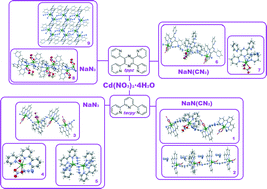Coordination assemblies of CdII with 2,2′:6′,2′′-terpyridine (terpy), 2,3,5,6-tetra-(2-pyridyl)pyrazine (tppz) and pseudohalide ions – structural diversification and luminescence properties†
Abstract
Nine new terpy- or tppz-containing cadmium(II) coordination compounds, [Cd(μ1,5-dca)(NO3)(terpy)]n (1), [Cd(μ1,5-dca)(terpy)(H2O)]n·n(dca) (2), [Cd(μ1,3-N3)(NO3)(terpy)]n (3), [Cd(N3)(NO3)(terpy)(H2O)] (4), [Cd2(μ1,1-N3)2(N3)2(terpy)2] (5), [Cd(μ1,5-dca)(NO3)(tppz)]n (6), [Cd(dca)(NO3)(tppz)(H2O)] (7), [Cd2(μ1,1-N3)2(NO3)2(μ-tppz)]n·2nMeOH (8) and [Cd2(μ1,1-N3)(μ1,3-N3)(m-tppz)]n (9), have been successfully synthesized in the reaction of Cd(NO3)2 with multidentate N-heterocyclic ligands and inorganic ions (N3− and N(NC)2− abbreviated as dca−). The resulting compounds were structurally characterized by single crystal X-ray diffraction analysis and further characterized by infrared spectra (IR), elemental analyses, powder X-ray diffraction (XRPD), and thermogravimetric analyses (TGA). The X-ray studies demonstrated a cooperative impact of the polypyridyl ligand and the auxiliary inorganic ion on the final molecular architectures of cadmium(II) coordination compounds. Different topologies, ranging from mononuclear molecular to two-dimensional coordination networks, were confirmed for 1–9. The photoluminescence behaviour of 1–9 was also discussed. All of these coordination compounds are luminescent in the solid state, with the emission maxima varying in the visible light region within the range of 460–600 nm. The difference in emission behaviour for 1–9 is attributed to the coordination environments of the metal ions and the rigidity of solid-state crystal packing.


 Please wait while we load your content...
Please wait while we load your content...